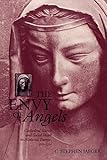The Envy of Angels : Cathedral Schools and Social Ideals in Medieval Europe, 950-1200 / C. Stephen Jaeger.
Material type: TextSeries: The Middle Ages SeriesPublisher: Philadelphia : University of Pennsylvania Press, [2013]Copyright date: ©1995Description: 1 online resource (544 p.) : 8 illusContent type:
TextSeries: The Middle Ages SeriesPublisher: Philadelphia : University of Pennsylvania Press, [2013]Copyright date: ©1995Description: 1 online resource (544 p.) : 8 illusContent type: - 9780812217452
- 9780812200300
- 370/.94/0902 20
- LA95 .J34 1994eb
- online - DeGruyter
- Issued also in print.
| Item type | Current library | Call number | URL | Status | Notes | Barcode | |
|---|---|---|---|---|---|---|---|
 eBook
eBook
|
Biblioteca "Angelicum" Pont. Univ. S.Tommaso d'Aquino Nuvola online | online - DeGruyter (Browse shelf(Opens below)) | Online access | Not for loan (Accesso limitato) | Accesso per gli utenti autorizzati / Access for authorized users | (dgr)9780812200300 |
Frontmatter -- Contents -- Acknowledgments -- Abbreviations -- Introduction -- 1. Two Models of Carolingian Education -- 2. Court and School in Ottoman Times -- 3. The New Education Institutionalized: Schools of Manners -- 4. Cultus Vinutum -- 5. Ethics Colonizing the Liberal Arts -- 6. Conclusion to Part I: Outbidding the Gods -- 7. Two Crises -- 8. Old Learning Against New -- Introduction to Part 3 -- 9. Humanism and Ethics at the School of St. Victor -- 10.. Bernard or Clairvaux -- 11. Twelfth-Century Humanism -- 12. Court Society -- Conclusion -- Appendix A. Moral Discipline and Gothic Sculpture: The Wise and Foolish Virgins of the Strassburpf Cathedral -- Appendix B. The Letter ofGoswin of Mainz to His Student Watcher (ca. 1065) -- Notes -- Bibliography -- Index
restricted access online access with authorization star
http://purl.org/coar/access_right/c_16ec
Before the rise of universities, cathedral schools educated students in a course of studies aimed at perfecting their physical presence, their manners, and their eloquence. The formula of cathedral schools was "letters and manners" (litterae et mores), which asserts a pedagogic program as broad as the modern "letters and science." The main instrument of what C. Stephen Jaeger calls "charismatic pedagogy" was the master's personality, his physical presence radiating a transforming force to his students. In The Envy of Angels, Jaeger explores this intriguing chapter in the history of ideas and higher learning and opens a new view of intellectual and social life in eleventh- and early twelfth-century Europe.
Issued also in print.
Mode of access: Internet via World Wide Web.
In English.
Description based on online resource; title from PDF title page (publisher's Web site, viewed 23. Jul 2020)


